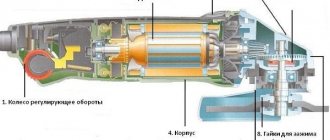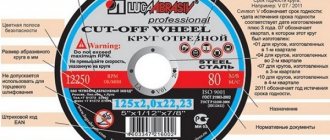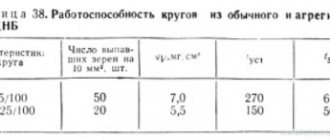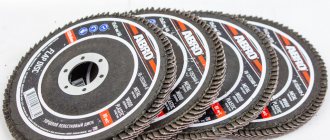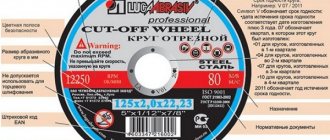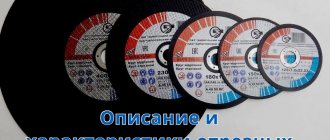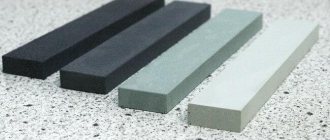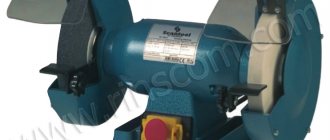The variety of work performed with the help of grinders is largely ensured by the wide range of tools that work with them.
For each standard size angle grinder, you can always select consumables that correspond to the characteristics and dimensions. One of the parameters that determines the capabilities of an angle grinder is the maximum diameter of the disk that is installed on it. It determines the speed, engine power and torque. The choice of disk size is closely related to the nature of the work performed by the grinder.
Types of circles
The circles (disks) of grinders differ according to the following indicators:
- work performed that determines the purpose of the tool;
- composition of the material;
- dimensions.
Technological features
The necessary processing technology is provided by the following consumables.
- — Cutting wheels. Mainly used for processing metals, less often for other types of materials.
- — Grinding wheels. Different designs allow you to perform both roughing or cleaning, and bringing the surface roughness to the desired condition.
- — Polishing discs and attachments. Bring the surface to a shine using felt or other fabric with similar properties.
By material
The operating modes are influenced by the material component from which the tool is made.
- — Abrasive disc. The basis that served for the manufacture of the tool is the abrasive material itself, a binder, for example, bakelite and various fillers. Mainly used for metal processing.
- — Diamond wheel (with diamond coating). With its help, you can process materials of any strength (various types of stone, ceramics, quartz glass and many other similar ones consisting of solid fractions).
Dimensions
The main classification criterion here is the diameter of the disc. The depth of the cut depends on its size (it is approximately a quarter of the diameter). The functionality of an angle grinder is determined by the size of the tool: a small diameter makes it possible to process a light angle grinder in hard-to-reach places, while a larger size angle grinder with greater productivity will be difficult and unsafe to hold “in weight”.
Price and manufacturers
metal disc from Hitachi
For rare household jobs, cutting discs from the low price category are quite suitable: “Sparta”, “Zubr”, “Tsentroinstrument”. With occasional use they will last quite a long time.
The quality of the abrasive material is not bad, the price is reasonable. The main thing when working with consumables of this class is not to work for a long time without breaks. If the circle stops sawing, it is cleaned with red or yellow brick.
Professional metal discs cost 3 times more. But only they are suitable for industrial use. These are consumables, “Distar”, “Hitachi”. They withstand daily work with the most difficult materials. Professional circles, as a rule, are intended to work with a specific material: reinforced concrete, granite, tiles, steel, non-ferrous metals.
Video with a metal cutting disc test:
Marking
The choice of the right tool is facilitated by the presence of markings. It contains the technical parameters of consumables in encrypted form. For example, this is what an alphanumeric set of markings for a cutting disc looks like, produced by a Russian manufacturer:
- — The image shows the tool manufacturer — Luga Abrasive Plant (Luga, Leningrad Region).
- — Tool name:
- cutting wheel - in Russian;
- cut –off – wheel – in English translation.
- — Purpose: for processing steel (inscriptions “steel”, “steel” on the circle).
- — The dimensions of the circle are indicated (outer diameter x thickness x bore diameter):
- in mm – 200 x 2.5 x 22.23;
- in inches – 8”x 1/10”x 7/8”;
- digital designation "41". This is a characteristic of the design of the circle - here it is flat.
- — The circle is designed for 7650 rpm, while the maximum peripheral speed should not exceed 80 m/s.
- — Technical parameters of the wheel material are determined from the designation “A 30 S BF”, where:
- A – means that the abrasive is based on white electrocorundum, which is specifically used for metal processing;
- 30 – abrasive grain size, here it is average;
- S – hardness of the circle, here the circle is hard;
- BF - denotes the type of bond, here synthetic resins with glass fiber reinforcement.
- — Rules for safe work in the form of signs indicating the required action.
- - GOST 21963 - 2002, GOST R 52588 - 2011, EN 12413 - Russian and European regulatory documents to which this tool complies.
The marking of a foreign manufacturer of tools for angle grinders is as follows:
- — Tools under the NORTON VULKAN brand are produced by the Saint Gobain corporation, headquartered in France.
- —The purpose of the cutting disc (the company produces only such a tool for angle grinders) for processing steel (in addition, for visualization purposes, the label for wheels intended for metal processing is blue) is duplicated in several languages.
- — The circle is designed for 12250 rpm with a maximum peripheral speed of 80 m/s.
- — The dimensions are the same as on the Russian disk - in mm and inches.
- — The digital designation “41” has been added to the technical parameters of “A60S – BF41”. This is a characteristic of the design of the circle - here it is flat.
- — Methods of safe work must be indicated.
- — The regulatory documents to which the instrument complies are issued by the European Union.
What are the sizes of wheels for angle grinders Bosch, Interskol and more?
Almost all large companies produce grinders covering the maximum number of works - from household to industrial designs. Each type has its own tool size. In addition to the production of angle grinders, such manufacturers (Bosch, Metabo, Interskol and others) have mastered the parallel production of consumables. They select a special composition and standard size of consumables in order to maximize the operating efficiency of the specific model they produce.
Outer and bore diameter, maximum and minimum value
The most popular range of angle grinder sizes consists of the following values.
External diameter . The most preferred sizes are: 115 mm, 125 mm, 150 mm, 180 mm, 200 mm and 230 mm. In rare cases, to perform, for example, jewelry work with small parts, portable battery-powered angle grinders with diameters of 76 mm or 100 mm are used.
The minimum diameter of 115 mm is used for simple work in the form of processing hard-to-reach surfaces in the household. Anglers with a circle with a diameter of 125 mm have greater ability to perform various household works.
The diameter of 230 mm is used in the professional context of angle grinders for large volumes of work, for example, in construction. Circles with a diameter of more than 230 mm are installed on stationary equipment.
Thickness _ Cutting wheels are available in thicknesses from 0.8 mm to 5.0 mm. Moreover, a larger diameter should have a circle with a correspondingly greater thickness.
You should know! A thin disc is easy to cut, but it is also more likely to break.
Landing diameter . The standard mounting diameter for angle grinder consumables is 22.23 mm. In the vast majority of cases, it is the same for all disk sizes. It is rare to find mounting diameters of 10 mm, 13 mm, 16 mm due to the limited use of angle grinders with a diameter smaller than 100 mm. A 32 mm bore diameter is used with circles of 300 mm and larger on stationary equipment.
Advantages and disadvantages
Like any product produced by modern industry, cutting wheels have their own pros and cons. Let's consider only the main ones.
Abrasive consumables
Among the advantages of disks of this type it is worth highlighting:
- during active use the wheel does not become dull;
- cooling occurs naturally due to the porous structure;
- there is a wide range of product items on the market;
- acceptable price;
The disadvantages of abrasive consumables/tools include:
- wear out quickly;
- cutting is accompanied by the appearance of a characteristic, rather strong odor in the surrounding area;
- During the work, sheaves of bright sparks are formed.
Diamond cutting wheels
Such products have the following advantages:
- minimal formation of sparks during the cutting procedure;
- absence of a strong unpleasant burning smell;
- high wear resistance;
- increased cutting accuracy.
Among the disadvantages of diamond-containing cutting wheels, home craftsmen with extensive experience highlight:
- low level of thermal resistance;
- considerable price.
For large, medium and small angle grinders
The power classification into small, medium and large is closely related to dimensions and weight. The greater the power, the greater the weight and overall dimensions.
So, for example, grinders with disks of 115 mm - 125 mm and a power of 0.6 kW to 1.2 kW are classified as small equipment.
Angler grinders with discs of 150 mm - 180 mm and a power of up to 2.0 kW belong to the middle class of such equipment.
Professional angle grinders with a power of up to 3.0 kW and a disc diameter of 230 mm conventionally belong to large angle grinders.
Review and comparison of cutting wheels
| Model | Outer diameter, mm | Thickness, mm | Price, rub |
| LUGA-ABRAZIV 115Х1.6Х22 А40 | 115 | 1,6 | 17 |
| KRATON 1 07 02 026 | 115 | 1,6 | 23 |
| ATTACK 1458910 | 125 | 1,6 | 56 |
| DEWALT DT42301-XJ | 125 | 3 | 89 |
| BOSCH Expert for Inox 180Х2,0Х22 | 180 | 2 | 110 |
| STOMER CD-230T | 230 | 1,8 | 235 |
LUGA-ABRAZIV
CRATON
ATTACK
DEWALT
BOSCH
STOMER
For metal, concrete, wood and other materials
To effectively process any material, it is important to choose the right power so that it matches the diameter of the tool and its thickness. In addition, the consumable must have suitable characteristics for processing a specific type of workpiece material.
The main difference between discs for steel, cast iron, and non-ferrous metals is in the composition of the fillers. To process alloy steels, a very strong additive is added to the disc material that can overcome the resistance of alloy steel. When processing non-ferrous metals, on the contrary, a soft filler is added, which works effectively when processing viscous materials.
Disc for aluminum
To process concrete (tiles, paving slabs), diamond discs are used (actually, these are metal circles coated with diamond).
Tile disc
It is not recommended to process wood with an angle grinder due to the high risk of injury. If such a need nevertheless arises, then the best option would be a grinder with a disk with a diameter of 125 mm. As a working tool, special angle grinder discs for wood should be used.
Wood disc
DO NOT ATTEMPT TO CUT WITH A SANDING DISC OR GRIND WITH A CUT-OFF DISC
An angle grinder solves a wide range of problems, and each type of disk or attachment has its own purpose. Each one says what material it is intended for, its dimensions and maximum speed.
If you try to use, for example, a cutting wheel for grinding or vice versa, you risk breaking it, and numerous fragments can cause serious injury to you and those around you. An angle grinder is a rather dangerous tool and requires compliance with safety precautions.
Source
How to choose
The main criterion for choosing the disk size will be the nature of the work performed. In the household, these will be circles of smaller diameters; in a production environment, a tool of large diameter (230 mm) is used.
In addition to the dimensional characteristics, you should carefully check the compliance of the disc material with the material of the workpiece being processed.
Another determining factor is the power of the grinder. It is directly related to the weight and overall characteristics of an angle grinder. With approximately the same characteristics, preference should be given to a lighter specimen.
How to replace
The grinder disc is a consumable item. Therefore, it has to be changed frequently. There is a simple algorithm in which an important role is played by the original design of the key supplied to the consumer along with the grinder.
- — The protruding rods of a special key are installed in the grooves of the fastening nut.
- — At the same time, press the lock button located on the gearbox housing. It will lock the rotor from turning.
- — Turn the key counterclockwise to release the fasteners of the worn disk.
- — The old disk is replaced with a new one of the same technical characteristics and size. The new disk is installed with the markings facing out to remind you of the disk parameters and for other good reasons (see explanation in the video above).
- — The fastening nut is first tightened by hand and finally tightened with a special wrench.
The Bulgarian is ready to continue fulfilling its functional purpose.

